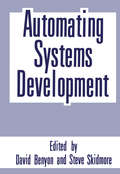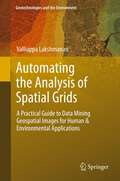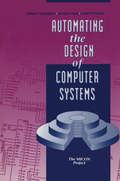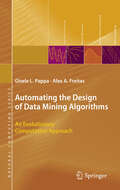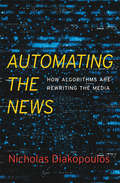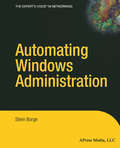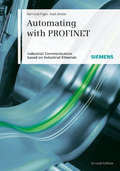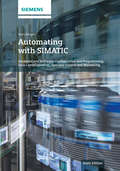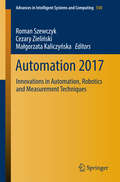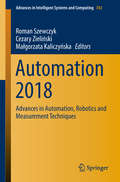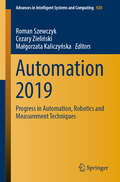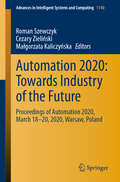- Table View
- List View
Automating Systems Development
by David R. Benyon Steve Skidmore1 INTRODUCTION These proceedings are the result of a conference on Automating Systems Development held at Leicester Polytechnic, England on 14 to 16 April 1987. The conference was attended by over 170 delegates from industry and academia and it represents a comprehensive review of the state of the art of the use of the computer based tools for the analysis, design and construction of Information Systems (IS). Two parallel streams ran throughout the conference. The academic, or research, papers were the fruit of British, European and Canadian research, with some of the papers reflecting UK Government funded Alvey or European ESPRIT research projects. Two important touchstones guided the selection of academic papers. Firstly, they should be primarily concerned with system, rather than program, development. Secondly, they should be easily accessible to delegates and readers. We felt that formal mathematical papers had plenty of other opportunities for airing and publication. The second stream was the applied programme; a set of formal presentations given by leading software vendors and consultancies. It is clear that many advances in systems development are actually applied, rather than re search led. Thus it was important for delegates to hear how leading edge companies view the State of the Art. This was supported by a small exhibi tion area where certain vendors demonstrated the software they had intro duced in the formal presentation.
Automating the Analysis of Spatial Grids: A Practical Guide to Data Mining Geospatial Images for Human & Environmental Applications (Geotechnologies and the Environment #6)
by Valliappa LakshmananThe ability to create automated algorithms to process gridded spatial data is increasingly important as remotely sensed datasets increase in volume and frequency. Whether in business, social science, ecology, meteorology or urban planning, the ability to create automated applications to analyze and detect patterns in geospatial data is increasingly important. This book provides students with a foundation in topics of digital image processing and data mining as applied to geospatial datasets. The aim is for readers to be able to devise and implement automated techniques to extract information from spatial grids such as radar, satellite or high-resolution survey imagery.
Automating the Design of Computer Systems
by William P. Birmingham Anurag P. Gupta Daniel P. SiewiorekAddressing the issues of engineering design in computer architecture, this book describes the design and implementation of MICON, a system for automating the synthesis of small computers.
Automating the Design of Data Mining Algorithms: An Evolutionary Computation Approach (Natural Computing Series)
by Gisele L. Pappa Alex FreitasData mining is a very active research area with many successful real-world app- cations. It consists of a set of concepts and methods used to extract interesting or useful knowledge (or patterns) from real-world datasets, providing valuable support for decision making in industry, business, government, and science. Although there are already many types of data mining algorithms available in the literature, it is still dif cult for users to choose the best possible data mining algorithm for their particular data mining problem. In addition, data mining al- rithms have been manually designed; therefore they incorporate human biases and preferences. This book proposes a new approach to the design of data mining algorithms. - stead of relying on the slow and ad hoc process of manual algorithm design, this book proposes systematically automating the design of data mining algorithms with an evolutionary computation approach. More precisely, we propose a genetic p- gramming system (a type of evolutionary computation method that evolves c- puter programs) to automate the design of rule induction algorithms, a type of cl- si cation method that discovers a set of classi cation rules from data. We focus on genetic programming in this book because it is the paradigmatic type of machine learning method for automating the generation of programs and because it has the advantage of performing a global search in the space of candidate solutions (data mining algorithms in our case), but in principle other types of search methods for this task could be investigated in the future.
Automating the News: How Algorithms Are Rewriting the Media
by Nicholas DiakopoulosFrom hidden connections in big data to bots spreading fake news, journalism is increasingly computer-generated. Nicholas Diakopoulos explains the present and future of a world in which algorithms have changed how the news is created, disseminated, and received, and he shows why journalists—and their values—are at little risk of being replaced.
Automating Translation (Routledge Introductions to Translation and Interpreting)
by Joss Moorkens Andy Way Séamus LankfordTranslation technology is essential for translation students, practising translators, and those working as part of the language services industry, but looming above others are the tools for automating translation: machine translation and, more recently, generative AI based on large language models (LLMs).This book, authored by leading experts, demystifies machine translation, explaining its origins, its training data, how neural machine translation and LLMs work, how to measure their quality, how translators interact with contemporary systems for automating translation, and how readers can build their own machine translation or LLM. In later chapters, the scope of the book expands to look more broadly at translation automation in audiovisual translation and localisation. Importantly, the book also examines the sociotechnical context, focusing on ethics and sustainability. Enhanced with activities, further reading and resource links, including online support material on the Routledge Translation studies portal, this is an essential textbook for students of translation studies, trainee and practising translators, and users of MT and multilingual LLMs.
Automating Translation (Routledge Introductions to Translation and Interpreting)
by Joss Moorkens Andy Way Séamus LankfordTranslation technology is essential for translation students, practising translators, and those working as part of the language services industry, but looming above others are the tools for automating translation: machine translation and, more recently, generative AI based on large language models (LLMs).This book, authored by leading experts, demystifies machine translation, explaining its origins, its training data, how neural machine translation and LLMs work, how to measure their quality, how translators interact with contemporary systems for automating translation, and how readers can build their own machine translation or LLM. In later chapters, the scope of the book expands to look more broadly at translation automation in audiovisual translation and localisation. Importantly, the book also examines the sociotechnical context, focusing on ethics and sustainability. Enhanced with activities, further reading and resource links, including online support material on the Routledge Translation studies portal, this is an essential textbook for students of translation studies, trainee and practising translators, and users of MT and multilingual LLMs.
Automating Vision: The Social Impact of the New Camera Consciousness
by Anthony McCosker Rowan WilkenAutomating Vision explores the rise of seeing machines through four case studies: facial recognition, drone vision, mobile and locative media and driverless cars. Proposing a conceptual lens of camera consciousness, which is drawn from the early visual anthropology of Gregory Bateson and Margaret Mead, Automating Vision accounts for the growing power and value of camera technologies and digital image processing. Behind the smart camera devices examined throughout the book lies a set of increasingly integrated and automated technologies underpinned by artificial intelligence, machine learning and image processing. Seeing machines are now implicated in growing visual data markets and are supported by emerging layers of infrastructure that they coproduce. In this book, Anthony McCosker and Rowan Wilken address the social impacts, the disruptions and reconfigurations to existing digital media ecosystems, to urban environments and to mobility and social relations that result from the increasing automation of vision and explore how it might be possible to ensure a safe and equitable future as we learn to see with and negotiate the interventions of seeing machines. This book will appeal to students and scholars in media, communication, cultural studies, sociology of media and science and technology studies.
Automating Vision: The Social Impact of the New Camera Consciousness
by Anthony McCosker Rowan WilkenAutomating Vision explores the rise of seeing machines through four case studies: facial recognition, drone vision, mobile and locative media and driverless cars. Proposing a conceptual lens of camera consciousness, which is drawn from the early visual anthropology of Gregory Bateson and Margaret Mead, Automating Vision accounts for the growing power and value of camera technologies and digital image processing. Behind the smart camera devices examined throughout the book lies a set of increasingly integrated and automated technologies underpinned by artificial intelligence, machine learning and image processing. Seeing machines are now implicated in growing visual data markets and are supported by emerging layers of infrastructure that they coproduce. In this book, Anthony McCosker and Rowan Wilken address the social impacts, the disruptions and reconfigurations to existing digital media ecosystems, to urban environments and to mobility and social relations that result from the increasing automation of vision and explore how it might be possible to ensure a safe and equitable future as we learn to see with and negotiate the interventions of seeing machines. This book will appeal to students and scholars in media, communication, cultural studies, sociology of media and science and technology studies.
Automating Windows Administration
by Stein Borge* Covers common administration tasks for Exchange 5.5, Exchange 2000, Exchange 2003, Internet Information Server (IIS) 4 and 5 and 6, and Windows NT 4, 2000, XP and Windows 2003. * Extensive examples using Windows Management Instrumentation (WMI), which provides registry, network/system administrative, and security operations. * This book is the analog of the tools that were used in our very successful book, ISBN 1590592123 Automating UNIX and Linux Administration (Apress, 2003) for similar tasks.
Automating with PROFINET: Industrial Communication Based on Industrial Ethernet
by Raimond Pigan Mark MetterPROFINET is the first integrated Industrial Ethernet Standard for automation, and utilizes the advantages of Ethernet and TCP/IP for open communication from the corporate management level to the process itself. PROFINET CBA divides distributed, complex applications into autonomous units of manageable size. Existing fieldbuses such as PROFIBUS and AS-Interface can be integrated using so-called proxies. This permits separate and cross-vendor development, testing and commissioning of individual plant sections prior to the integration of the solution as a whole. PROFINET IO, with its particularly fast real-time communication, fulfills all demands currently placed on the transmission of process data and enables easy integration of existing fieldbus systems. Isochronous real-time (IRT) is used for isochronous communication in motion control applications. PROFINET depends on established IT standards for network management and teleservice. Particulary to automation control engineering it offers a special security concept. Special industrial network technology consisting of active network components, cables and connection systems, together with recommendations for installation, complete the concept. This book serves as an introduction to PROFINET technology. Configuring engineers, commissioning engineers and technicians are given an overview of the concept and the fundamentals they need to solve PROFINET-based automation tasks. Technical relationships and practical applications are described using SIMATIC products as example.
Automating with SIMATIC: Controllers, Software, Programming, Data Communication Operator Control and Process Monitoring
by Hans BergerTotally Integrated Automation is the concept by means of which SIMATIC controls machines, manufacturing systems and technical processes. Taking the example of the S7-300/400 programmable controller, this book provides a comprehensive introduction to the architecture and operation of a state-of-the-art automation system. It also gives an insight into configuration and parameter setting for the controller and the distributed I/O. Communication via network connections is explained, along with a description of the available scope for operator control and monitoring of a plant. As the central automation tool, STEP 7 manages all relevant tasks and offers a choice of various text and graphics-oriented PLC programming languages. The available languages and their respective different features are explained to the reader. The fourth edition describes the latest components and functions. The STEP 7 basic software is explained in its latest version. New functions for Profinet IO and the open communication over Industrial Ethernet have been added. The book is ideal for those who have no extensive prior knowledge of programmable controllers and wish for an uncomplicated introduction to this subject.
Automating with SIMATIC: Hardware and Software, Configuration and Programming, Data Communication, Operator Control and Monitoring
by Hans BergerThe book provides a complete overview of the SIMATIC automation system and the TIA Portal with the engineering tool STEP 7. "Automating with SIMATIC" addresses all those who - want to get an overview of the components of the system and their features, - wish to familiarize themselves with the topic of programmable logic controllers, or - intend to acquire basic knowledge about configuration, programming and interaction of the SIMATIC components. At first, the book introduces the hardware of SIMATIC S7-1200, S7-300, S7-400 and S7-1500, including the ET 200 peripheral modules. This is followed by describing the work with STEP 7 in the programming languages LAD, FBD, STL, SCL and S7-Graph, and offline testing with S7-PLCSIM. The next section describes the structure of the user program, which is followed by the illustration of the data communication between the controllers of the automation system as well as with the peripheral devices by use of the bus systems Profinet and Profibus. The book closes with a survey of the devices for operator control and process monitoring and their configuration software.
Automating with SIMATIC S7-1200: Configuring, Programming and Testing with STEP 7 Basic
by Hans BergerThis book addresses both beginners and users experienced in working with automation systems. It presents the hardware components of S7-1200 and illustrates their configuration and parametrization, as well as the communication via PROFINET, PROFIBUS, AS-Interface und PtP-connections. A profound introduction into STEP 7 Basic illustrates the basics of programming and troubleshooting.
Automating with SIMATIC S7-1500: Configuring, Programming and Testing with STEP 7 Professional
by Hans BergerThe SIMATIC S7-1500 programmable logic controller (PLC) sets standards in productivity and efficiency. By its system performance and with PROFINET as the standard interface, it ensures short system response times and a maximum of flexibility and networkability for demanding automation tasks in the entire production industry and in applications for medium-sized to high-end machines. The engineering software STEP 7 Professional operates inside TIA Portal, a user interface that is designed for intuitive operation. Functionality includes all aspects of automation: from the configuration of the controllers via programming in the IEC languages LAD, FBD, STL, and SCL up to the program test. In the book, the hardware components of the automation system S7-1500 are presented including the description of their configuration and parameterization. A comprehensive introduction into STEP 7 Professional V14 illustrates the basics of programming and troubleshooting. Beginners learn the basics of automation with Simatic S7-1500, users switching from other controllers will receive the relevant knowledge.
Automating with SIMATIC S7-300 inside TIA Portal: Configuring, Programming and Testing with STEP 7 Professional
by Hans BergerSIMATIC S7-300 has been specially designed for innovative system solutions in the manufacturing industry, and with a diverse range of controllers it offers the optimal solution for applications in centralized and distributed configurations. Alongside standard automation safety technology and motion control can also be integrated. The TIA Portal user interface is tuned to intuitive operation and encompasses all the requirements of automation within its range of functions: from configuring the controller, through programming in the different languages, all the way to the program test and simulation. For beginners engineering is easy to learn and for professionals it is fast and efficient. This book describes the configuration of devices and network for the S7-300 components inside the new engineering framework TIA Portal. With STEP 7 Professional V12, configuring and programming of all SIMATIC controllers will be possible in a simple and efficient way; in addition to various technology functions the block library also contains a PID control. As reader of the book you learn how a control program is formulated and tested with the programming languages LAD, FBD, STL and SCL. Descriptions of configuring the distributed I/O with PROFIBUS DP and PROFINET IO using SIMATIC S7-300 and exchanging data via Industrial Ethernet round out the book.
Automating with SIMATIC S7-400 inside TIA Portal: Configuring, Programming and Testing with STEP 7 Professional
by Hans BergerThis book presents a comprehensive description of the configuration of devices and network for the S7-400 components inside the engineering framework TIA Portal. You learn how to formulate and test a control program with the programming languages LAD, FBD, STL, and SCL. The book is rounded off by configuring the distributed I/O with PROFIBUS DP and PROFINET IO using SIMATIC S7-400 and data exchange via Industrial Ethernet. SIMATIC is the globally established automation system for implementing industrial controllers for machines, production plants and processes. SIMATIC S7-400 is the most powerful automation system within SIMATIC. This process controller is ideal for data-intensive tasks that are especially typical for the process industry. With superb communication capability and integrated interfaces it is optimized for larger tasks such as the coordination of entire systems. Open-loop and closed-loop control tasks are formulated with the STEP 7 Professional V11 engineering software in the field-proven programming languages Ladder Diagram (LAD), Function Block Diagram (FBD), Statement List (STL), and Structured Control Language (SCL). The TIA Portal user interface is tuned to intuitive operation and encompasses all the requirements of automation within its range of functions: from configuring the controller, through programming in the different languages, all the way to the program test. Users of STEP 7 Professional V12 will easily get along with the descriptions based on the V11. With start of V12, the screens of the technology functions might differ slightly from the V11.
Automating with STEP 7 in LAD and FBD: SIMATIC S7-300/400 Programmable Controllers
by Hans BergerSIMATIC is the worldwide established automation system for implementing industrial control systems for machines, manufacturing plants and industrial processes. Relevant open-loop and closed-loop control tasks are formulated in various programming languages with the engineering software STEP 7.Ladder diagram (LAD) and function block diagram (FBD) use graphic symbols to display the monitoring and control functions similar those used in schematic circuit diagrams or electronic switching systems. Now in its fifth edition, this book describes these graphic-oriented programming languages combined with the engineering software STEP 7 V5.5 for use with both SIMATIC S7-300 and SIMATIC S7-400 automation systems. New functions of this STEP 7 version are especially related to CPU-Webserver and PROFINET IO like for example the application of I devices, shared devices and isochrone mode.It is aimed at all users of SIMATIC S7 controllers. First-time users are introduced to the field of programmable controllers, while advanced users learn about specific applications of the SIMATIC S7 automation system.All programming examples found in the book - and even a few extra examples - are available over the publisher's website under Downloads.
Automating with STEP 7 in STL and SCL: SIMATIC S7-300/400 Programmable Controllers
by Hans BergerSIMATIC is the worldwide established automation system for implementing industrial control systems for machines, manufacturing plants and industrial processes. Relevant open-loop and closed-loop control tasks are formulated in various programming languages with the programming software STEP 7. Now in its sixth edition, this book gives an introduction into the latest version of engineering software STEP 7 (basic version) . It describes elements and applications of text-oriented programming languages statement list (STL) and structured control language (SCL) for use with both SIMATIC S7-300 and SIMATIC S7-400, including the new applications with PROFINET and for communication over industrial Ethernet. It is aimed at all users of SIMATIC S7 controllers. First-time users are introduced to the field of programmable controllers, while advanced users learn about specific applications of the SIMATIC S7 automation system. All programming examples found in the book - and even a few extra examples - are available at the download area of the publisher's website.
Automating Workflows With Github Actions (PDF0: Automate Software Development Workflows And Seamlessly Deploy Your Applications Using Github Actions
by Priscila HellerBuild, test, and deploy code right from your GitHub repository by automating, customizing, and executing software development workflows with GitHub Actions Key Features Enhance your CI/CD and DevOps workflows using GitHub Actions Discover how to create custom GitHub Actions using Docker and JavaScript Get up and running with building a CI/CD pipeline effectively Book Description GitHub Actions is one of the most popular products that enables you to automate development tasks and improve your software development workflow. Automating Workflows with GitHub Actions uses real-world examples to help you automate everyday tasks and use your resources efficiently. This book takes a practical approach to helping you develop the skills needed to create complex YAML files to automate your daily tasks. You'll learn how to find and use existing workflows, allowing you to get started with GitHub Actions right away. Moving on, you'll discover complex concepts and practices such as self-hosted runners and writing workflow files that leverage other platforms such as Docker as well as programming languages such as Java and JavaScript. As you advance, you'll be able to write your own JavaScript, Docker, and composite run steps actions, and publish them in GitHub Marketplace! You'll also find instructions to migrate your existing CI/CD workflows into GitHub Actions from platforms like Travis CI and GitLab. Finally, you'll explore tools that'll help you stay informed of additions to GitHub Actions along with finding technical support and staying engaged with the community. By the end of this GitHub book, you'll have developed the skills and experience needed to build and maintain your own CI/CD pipeline using GitHub Actions. What you will learn Get to grips with the basics of GitHub and the YAML syntax Understand key concepts of GitHub Actions Find out how to write actions for JavaScript and Docker environments Discover how to create a self-hosted runner Migrate from other continuous integration and continuous delivery (CI/CD) platforms to GitHub Actions Collaborate with the GitHub Actions community and find technical help to navigate technical difficulties Publish your workflows in GitHub Marketplace Who this book is for This book is for anyone involved in the software development life cycle, for those looking to learn about GitHub Actions and what can be accomplished, and for those who want to develop a new skill to help them advance their software development career. If you are new to GitHub and GitHub Actions in general, then this book is for you. Basic knowledge of GitHub a
Automation: The Future Of Weed Control In Cropping Systems
by Stephen L. Young Francis J. PierceTechnology is rapidly advancing in all areas of society, including agriculture. In both conventional and organic systems, there is a need to apply technology beyond our current approach to improve the efficiency and economics of management. Weeds, in particular, have been part of cropping systems for centuries often being ranked as the number one production cost. Now, public demand for a sustainably grown product has created economic incentives for producers to improve their practices, yet the development of advanced weed control tools beyond biotech has lagged behind. An opportunity has been created for engineers and weed scientists to pool their knowledge and work together to ‘fill the gap’ in managing weeds in crops. Never before has there been such pressure to produce more with less in order to sustain our economies and environments. This book is the first to provide a radically new approach to weed management that could change cropping systems both now and in the future.
Automation 2017: Innovations in Automation, Robotics and Measurement Techniques (Advances in Intelligent Systems and Computing #550)
by Roman Szewczyk Cezary Zieliński Małgorzata KaliczyńskaThis book consists of papers presented at Automation 2017, an international conference held in Warsaw from March 15 to 17, 2017. It discusses research findings associated with the concepts behind INDUSTRY 4.0, with a focus on offering a better understanding of and promoting participation in the Fourth Industrial Revolution. Each chapter presents a detailed analysis of a specific technical problem, in most cases followed by a numerical analysis, simulation and description of the results of implementing the solution in a real-world context. The theoretical results, practical solutions and guidelines presented are valuable for both researchers working in the area of engineering sciences and practitioners looking for solutions to industrial problems.
Automation 2018: Advances in Automation, Robotics and Measurement Techniques (Advances in Intelligent Systems and Computing #743)
by Roman Szewczyk Cezary Zieliński Małgorzata KaliczyńskaThis book consists of papers presented at Automation 2018, an international conference held in Warsaw from March 21 to 23, 2018. It discusses the radical technological changes occurring due to the INDUSTRY 4.0, with a focus on offering a better understanding of the Fourth Industrial Revolution. Each chapter presents a detailed analysis of interdisciplinary knowledge, numerical modeling and simulation as well as the application of cyber-physical systems, where information technology and physical devices create synergic systems leading to unprecedented efficiency. The theoretical results, practical solutions and guidelines presented are valuable for both researchers working in the area of engineering sciences and practitioners looking for solutions to industrial problems.
Automation 2019: Progress in Automation, Robotics and Measurement Techniques (Advances in Intelligent Systems and Computing #920)
by Roman Szewczyk Cezary Zieliński Małgorzata KaliczyńskaThis book consists of papers presented at AUTOMATION2019, an international conference held in Warsaw from March 27 to 29, 2019. It discusses the radical technological changes occurring due to the INDUSTRY 4.0. To follow these changes, both scientists and engineers have to face the challenge of interdisciplinary approach directed at the development of cyber-physical systems. This approach encompasses interdisciplinary theoretical knowledge, numerical modelling and simulation as well as application of artificial intelligence techniques. Both software and physical devices are composed into systems that will increase production efficiency and resource savings. The theoretical results, practical solutions and guidelines presented are valuable for both researchers working in the area of engineering sciences and practitioners looking for solutions to industrial problems.
Automation 2020: Proceedings of Automation 2020, March 18–20, 2020, Warsaw, Poland (Advances in Intelligent Systems and Computing #1140)
by Roman Szewczyk Cezary Zieliński Małgorzata KaliczyńskaThis book presents the scientific outcomes of the International Conference AUTOMATION 2020, held on March 18–20, 2020 in Warsaw, Poland. The next 30 years will see radical innovations in production processes, transportation management and social life. The changes brought about by the transformation to zero-emission industry require advances in many fields, but especially in industrial automation, robotics and measurement techniques associated with the cyber-physical systems employing artificial intelligence that will be key to reducing costs and enabling European society to maintain its quality of live. In this context, the book features the latest research toward further developing these fields of engineering, and also offers solutions and guidelines that are useful for both researchers and engineers addressing problems associated with the world of ongoing radical changes.
